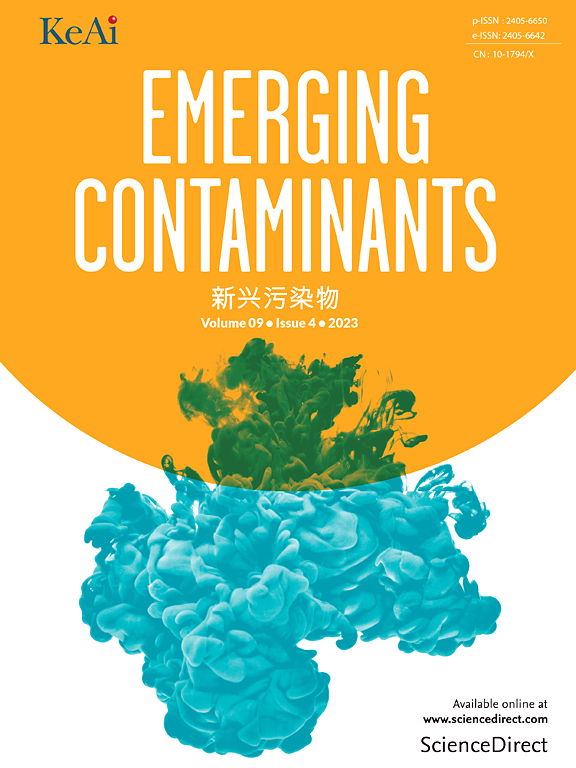6PPD及其醌衍生物(6PPDQ)的转化途径、检测、去除和可持续替代品综述
IF 6.9
2区 环境科学与生态学
Q1 ENVIRONMENTAL SCIENCES
引用次数: 0
摘要
N-(1,3-二甲基丁基)-N ' -苯基-对苯二胺(6PPD)是汽车轮胎中广泛使用的抗氧化剂和抗臭氧剂,常用于提高橡胶的耐久性和性能。然而,由于其在水生系统中的急性毒性,其环境转化,特别是通过臭氧化等氧化过程转化为6ppd -醌(6PPDQ)已成为一个严重的问题。6PPDQ在41纳克/升浓度下与包括鳕鱼在内的敏感鱼类的显著死亡率有关。本文综述了6PPD降解途径的最新进展,包括臭氧化、光降解、水解、微生物代谢和大气反应。本文系统地研究了各种TPs的形成和特征,并概述了在水、空气、土壤、沉积物和生物群中检测TPs的方法。它还评估了从污染介质中去除6PPDQ的处理方法的效率,如高级氧化工艺(AOPs)、微生物降解、吸附和膜技术。此外,综述了生物基、合成和工程抗氧化剂替代6PPD的新研究,重点介绍了它们的环境相容性和工业可行性。最后,本文全面概述了未来的研究重点,重点是提高分析检测,了解长期环境命运和毒性,优化处理技术,指导开发更安全的替代品。总的来说,本综述为橡胶制造业的环境风险评估、监管政策制定和可持续创新提供了基础。本文章由计算机程序翻译,如有差异,请以英文原文为准。
Transformation pathways, detection, removal, and sustainable alternatives of 6PPD and its quinone derivative (6PPDQ): A comprehensive review
N-(1,3-dimethylbutyl)-N′-phenyl-p-phenylenediamine (6PPD) is a widely used antioxidant and antiozonant in vehicle tires, commonly used to enhance rubber durability and performance. However, its environmental transformation, particularly into 6PPD-Quinone (6PPDQ) through oxidative processes like ozonation, has emerged as a serious concern due to the acute toxicity in aquatic systems. 6PPDQ has been linked to significant mortality in sensitive fish species, including coho salmon, at 41 ng/L concentrations. This review synthesizes recent advances in the understanding of 6PPD degradation pathways, including ozonation, photodegradation, hydrolysis, microbial metabolism, and atmospheric reactions. This paper systematically examines the formation and characterization of various TPs and outlines the methods used for their detection across water, air, soil, sediments, and biota. It also evaluates the efficiency of treatment approaches such as advanced oxidation processes (AOPs), microbial degradation, adsorption, and membrane technologies for the removal of 6PPDQ from contaminated media. Additionally, emerging research on bio-based, synthetic, and engineered antioxidant alternatives to 6PPD is reviewed, with attention to their environmental compatibility and industrial feasibility. The paper concludes with a comprehensive outline of future research priorities focused on improving analytical detection, understanding long-term environmental fate and toxicity, optimizing treatment technologies, and guiding the development of safer alternatives. Collectively, this review provides a foundation for environmental risk assessment, regulatory policy development, and sustainable innovation in rubber manufacturing.
求助全文
通过发布文献求助,成功后即可免费获取论文全文。
去求助
来源期刊

Emerging Contaminants
Medicine-Public Health, Environmental and Occupational Health
CiteScore
10.00
自引率
6.70%
发文量
35
审稿时长
44 days
期刊介绍:
Emerging Contaminants is an outlet for world-leading research addressing problems associated with environmental contamination caused by emerging contaminants and their solutions. Emerging contaminants are defined as chemicals that are not currently (or have been only recently) regulated and about which there exist concerns regarding their impact on human or ecological health. Examples of emerging contaminants include disinfection by-products, pharmaceutical and personal care products, persistent organic chemicals, and mercury etc. as well as their degradation products. We encourage papers addressing science that facilitates greater understanding of the nature, extent, and impacts of the presence of emerging contaminants in the environment; technology that exploits original principles to reduce and control their environmental presence; as well as the development, implementation and efficacy of national and international policies to protect human health and the environment from emerging contaminants.
 求助内容:
求助内容: 应助结果提醒方式:
应助结果提醒方式:


